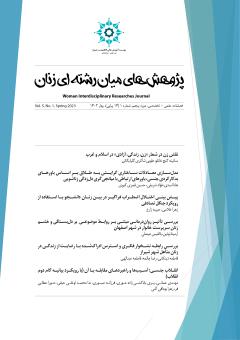پیش بینی اختلال اضطراب فراگیر در بین زنان دانشجو با استفاده از رویکرد جنگل تصادفی
محورهای موضوعی :
1 - واحد فیروزآباد، دانشگاه آزاد اسلامی، فیروزآباد، ایران.
2 - استادیارگروه زیست شناسی، دانشگاه پیام نور، تهران، ایران.
کلید واژه: داده کاوی, اختلال اضطراب فراگیر, جنگل تصادفی.,
چکیده مقاله :
سلامت روان یکی از بزرگترین چالش ها برای نسل کنونی است. اختلال اضطراب فراگیر (GAD) یکی از بسیاری از مشکلات سلامت روان است. افراد مبتلا به این اختلال نگرانی ها و تنش های اغراق آمیزی را در مورد رویدادهای روزمره تجربه می کنند. گزارش شده است که حدود 5 درصد از جمعیت کشورهای توسعه یافته به GAD مبتلا هستند و زنان دو برابر بیشتر از مردان به این بیماری مبتلا می شوند و یک اتفاق رو به رشد در بین زنان بالاخص زنان دانشجو است. این پژوهش با هدف پیش بینی اختلال اضطراب فراگیر در بین زنان دانشجو با رویکرد جنگل تصادفی، انجام شده است. از روش داده کاوی جهت پیش بینی استفاده شد.جامعه پژوهشی را زنان دانشجوی دانشگاه آزاد شیرازتشکیل دادند. تعداد 150 نفر از دانشجویان زن به روش تصادفی ساده انتخاب و با پرسشنامه DSM-IV, مورد ارزیابی قرار گرفتند. در این فرآیند، الگوریتم جنگل تصادفی برای تولید مدل پیشبینی پیشنهاد شده است. NetBeans IDE ابزاری بود که برای ساخت این پیاده سازی استفاده شد. جاوا زبان برنامه نویسی انتخاب شده برای کدگذاری این نمونه اولیه بود و از کتابخانه WEKA در این پیاده سازی استفاده شد. نتایج نشان داد که دقت پیشبینی با روش جنگل تصادفی بالای 0.9 است که نشان میدهد رویکرد جنگل تصادفی قادر به پیشبینی دقیق اختلال اضطراب فراگیر GAD است. برای ارزیابی ویژگی، رویکرد جنگل تصادفی در پیشبینی دقیق فردی که از GAD رنج نمیبرد سازگاری نشان میدهد. نتایج بهدستآمده از نمونه اولیه در مقایسه با خط پایه که در ابزار R پیادهسازی شده است، نسبتاً سازگار است. به طور خلاصه، رویکرد جنگل تصادفی عملکرد پیشبینی بالایی تولید میکند و میتواند روابط مهم بین پارامتر پیشنهادی و پارامتر وابسته را استخراج کند.
Mental health is considered one of the major challenges for the generations. Generalized anxiety disorder (GAD) is one of many mental health complications. However, individuals with the disorder experience hyperbolic concerns and tensions regarding daily events. Furthermore, it is reported that approximately 5% of the population of developed countries suffer from GAD. Additionally, women are affected by this disease twice as often as men, and it is an increasing disorder among women, particularly female students. This paper aims to predict generalized anxiety disorder among female students using the random decision forest algorithm. The data mining method was utilized for prediction. Female students of Shiraz Azad University developed the research community. Therefore, 150 female students were selected by simple random method and tested with a DSM-IV questionnaire. Accordingly, a random forest algorithm is proposed to generate a prediction model. Moreover, NetBeans IDE was applied for operationalization. Java was the programming language to code the prototype, and the WEKA library was involved in the operation. However, the results showed that the prediction accuracy with the random forest algorithm exceeds 0.9, which indicates that the algorithm is likely to predict GAD accurately. The random decision forest algorithm consistently predicts an individual not suffering from GAD. The results are relatively consistent compared to the baseline employed in the R. However, the random decision forest algorithm produces high predictive performance and may display significant relationships between the proposed and dependent parameters.
1- American Psychiatric Association, D. S. M. T. F., & American Psychiatric Association. (2013). Diagnostic and statistical manual of mental disorders: DSM-5 (Vol. 5, No. 5). Washington, DC: American psychiatric association.
2- Aminudin, M. A., Fadiawati, N., & Tania, L. (2015). Pengembangan LKS berbasis multipel representasi pada materi klasifikasi materi. Jurnal Pendidikan dan Pembelajaran Kimia, 4(2), 720-731.
3- Behar, E., DiMarco, I. D., Hekler, E. B., Mohlman, J., & Staples, A. M. (2009). Current theoretical models of generalized anxiety disorder (GAD): Conceptual review and treatment implications. Journal of anxiety disorders, 23(8), 1011-1023. doi:10.1016/j.janxdis.2009.07.006
4- Fayyad, U., Piatetsky-Shapiro, G., & Smyth, P. (1996). From data mining to knowledge discovery in databases. AI magazine, 17(3), 37-37. doi:10.1609/aimag.v17i3.1230
5- Khalilia, M., Chakraborty, S., & Popescu, M. (2011). Predicting disease risks from highly imbalanced data using random forest. BMC medical informatics and decision making, 11, 1-13. doi:10.1186/1472-6947-11-51
6- Loukis, E., & Maragoudakis, M. (2010, June). Heart murmurs identification using random forests in assistive environments. In Proceedings of the 3rd International Conference on Pervasive Technologies Related to Assistive Environments (pp. 1-6). doi:10.1145/1839294.1839304
7- Antony, M. M. (2013). Recommended Readings and DVDs Anxiety Disorders, Depression, and Related Problems. vol, 2631, 1-17.
8- Matthiesen, R. (Ed.). (2010). Bioinformatics methods in clinical research. Totowa, NJ, USA: Humana Press. doi:10.1007/978-1-60327-194-3_5
9- Oza, N. C. (2009). Ensemble data mining methods. In Encyclopedia of Data Warehousing and Mining, Second Edition (pp. 770-776). IGI Global. doi:10.4018/978-1-59140-557-3.ch085
10- Tomar, D., & Agarwal, S. (2013). A survey on Data Mining approaches for Healthcare. International Journal of Bio-Science and Bio-Technology, 5(5), 241-266.
11- Torpy, J. M. (2011). Generalized anxiety disorder. JAMA, 305(5), 522. doi:10.1001/jama.305.5.522
12- Van, A., Gay, V. C., Kennedy, P. J., Barin, E., & Leijdekkers, P. (2010, December). Understanding risk factors in cardiac rehabilitation patients with random forests and decision trees. In Conferences in Research and Practice in Information Technology Series.
13- Yoo, I., Alafaireet, P., Marinov, M., Pena-Hernandez, K., Gopidi, R., Chang, J. F., & Hua, L. (2012). Data mining in healthcare and biomedicine: a survey of the literature. Journal of medical systems, 36, 2431-2448. doi:10.1007/s10916-011-9710-5


